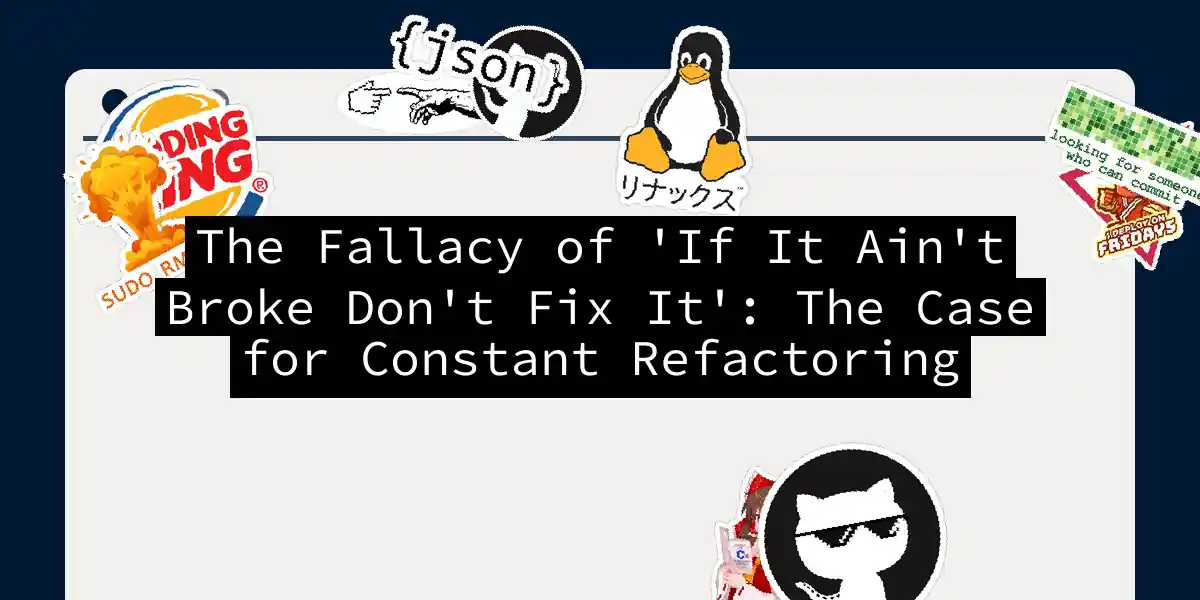In the world of software development, there’s a mantra that often gets tossed around like a hot potato: “If it ain’t broke, don’t fix it.” While this phrase might seem like sage advice, it’s a philosophy that can lead to a plethora of problems down the line. In this article, we’ll delve into why constant refactoring is not just a good practice, but a necessity in modern software development.
The Pitfalls of Complacency
Imagine you’re driving a car that’s been around since the 80s. It still runs, but it’s a gas guzzler, the brakes are iffy, and the air conditioning is more of a myth than a reality. Sure, it gets you from point A to point B, but at what cost? This is what happens when you apply the “if it ain’t broke” mentality to software.
Here are a few reasons why this approach is flawed:
Technical Debt
Technical debt is the cost of implementing quick fixes or workarounds that need to be revisited later. When you don’t refactor your code, you’re essentially accumulating technical debt. This debt can become so overwhelming that it slows down your development process, making it harder to add new features or fix bugs.
Maintenance Nightmare
Old, unrefactored code is like a puzzle with missing pieces. It’s hard to understand, harder to maintain, and nearly impossible to extend. When new developers join the team, they have to spend valuable time deciphering the codebase instead of contributing to it.
Security Risks
Outdated code often relies on deprecated libraries or frameworks that may have known security vulnerabilities. By not refactoring, you’re leaving your application open to potential attacks.
The Benefits of Refactoring
Refactoring is not just about fixing broken code; it’s about making your codebase better, more efficient, and more maintainable. Here are some benefits of constant refactoring:
Improved Readability
Refactored code is cleaner and more readable. This makes it easier for new team members to understand the codebase and contribute to it.
Performance Optimization
Refactoring can help identify bottlenecks in your code and optimize performance. This can lead to faster execution times and better user experiences.
Reduced Bugs
Clean, well-structured code is less prone to bugs. By refactoring regularly, you can catch and fix issues before they become major problems.
How to Refactor Effectively
Refactoring isn’t a one-time task; it’s an ongoing process. Here are some steps to help you refactor effectively:
Use Automated Tools
Tools like linters, code formatters, and automated refactoring tools can help identify and fix issues quickly.
Follow Best Practices
Adhere to coding standards and best practices. This includes using meaningful variable names, keeping functions short, and avoiding duplicated code.
Test Thoroughly
Before and after refactoring, run comprehensive tests to ensure that the changes haven’t introduced new bugs.
Use Version Control
Use version control systems like Git to track changes. This allows you to revert back to previous versions if something goes wrong.
Real-World Example
Let’s consider a simple example in Python. Suppose you have a function that calculates the area of a rectangle:
def calculate_area(length, width):
return length * width
def calculate_area_of_multiple_rectangles(rectangles):
total_area = 0
for rectangle in rectangles:
total_area += calculate_area(rectangle['length'], rectangle['width'])
return total_area
# Usage
rectangles = [
{'length': 10, 'width': 5},
{'length': 8, 'width': 4},
{'length': 6, 'width': 3}
]
print(calculate_area_of_multiple_rectangles(rectangles))
This code works but is not very efficient or readable. Here’s a refactored version:
def calculate_area(length, width):
"""Calculate the area of a rectangle."""
return length * width
def calculate_total_area(rectangles):
"""Calculate the total area of multiple rectangles."""
return sum(calculate_area(rectangle['length'], rectangle['width']) for rectangle in rectangles)
# Usage
rectangles = [
{'length': 10, 'width': 5},
{'length': 8, 'width': 4},
{'length': 6, 'width': 3}
]
print(calculate_total_area(rectangles))
In this refactored version, we’ve added docstrings for clarity, used a more Pythonic way of calculating the total area using a generator expression, and renamed the functions for better readability.
Conclusion
The “if it ain’t broke” mentality might seem like a safe bet, but it’s a recipe for disaster in software development. Constant refactoring is essential for maintaining a healthy, efficient, and secure codebase. By incorporating refactoring into your daily routine, you’re not just fixing what’s broken; you’re making your code better, faster, and more maintainable.
So, the next time you hear someone say “if it ain’t broke,” you can smile knowingly and say, “Actually, it’s probably just waiting to break.” And then, you can get to work refactoring. Because in the world of software, complacency is the enemy of excellence.
